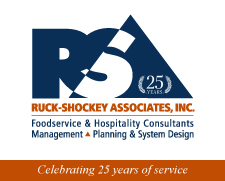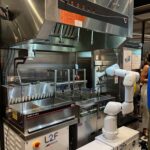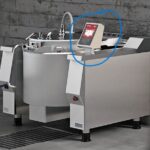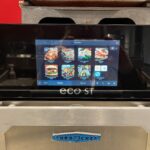
Celebrating Environmental Services Week with Gratitude and Pride
September 14-20
Posted on September 8th, 2025
At Ruck-Shockey Associates, Inc., we are honored to celebrate Environmental Services (EVS) Week—a dedicated time to recognize the essential professionals who keep our healthcare facilities (Hospitals, Long-term care facilities, rehab facilities), schools, offices, and public spaces safe, clean, and welcoming.
Environmental Services teams are truly at the core of healthy, vibrant environments. Their impact reaches far beyond cleaning: from supporting infection prevention and organizational wellness to building the confidence and comfort of colleagues, students, patients, and visitors each day. Whether it’s disinfecting high-touch surfaces, preparing patient rooms, maintaining clean classrooms, or ensuring smooth operations behind the scenes, EVS professionals play a crucial role in protecting every community they serve.
As we recognize their work, we’re reminded:
At Ruck-Shockey Associates, Inc., we’ve been privileged to collaborate with EVS leaders and dedicated staff across industries. Their commitment inspires us daily and is essential to the reputation and smooth operation of every organization.
To every Environmental Services professional — thank you!
Your unwavering dedication ensures cleaner, safer, and healthier spaces for everyone. You set the standard for safety, reliability, and care in every environment!
This EVS Week, let’s proudly celebrate your hard work, leadership, and meaningful impact—whether your role is in healthcare, education, business, industry, or public service. You make a real difference, and we are proud to stand with you.
From your partners at Ruck-Shockey Associates, Inc.
Happy Environmental Services Week!
Beyond the Paycheck: Why Celebration is Your EVS Team’s Secret Weapon
Posted on July 3rd, 2025
At the recent 2025 AHE Exchange, Donald Sipp of Ruck-Shockey and Associates Inc. delivered a powerful message in his “Beyond the Paycheck: Why People Quit” presentation: We all need to celebrate more! This isn’t just a feel-good sentiment; for healthcare Environmental Services (EVS) departments, fostering a culture of celebration is a strategic imperative for success.
EVS professionals are the unsung heroes, directly impacting infection prevention and patient experience. Yet, when their vital contributions go unnoticed, morale plummets, stress rises, and valuable talent walks out the door. Neglecting celebration leads to disengagement, burnout, and costly turnover, ultimately compromising the very quality and safety they strive to uphold.
The Power of Acknowledgment
Celebration, in its truest form, is a fundamental leadership practice. It’s about:
- Boosting Morale: Making employees feel seen, valued, and appreciated.
- Building Psychological Safety: Creating an environment where contributions are welcomed, and mistakes are learning opportunities.
- Strengthening Teams: Fostering camaraderie and a sense of belonging
- Enhancing Retention: Happy, recognized employees are more likely to stay.
Your Celebration Toolkit: Ideas from AHE
At the AHE Exchange, our discussion group even generated a word cloud filled with fantastic ideas for celebrating EVS teams. It was a vibrant testament to the creativity and shared commitment within our community! The suggestions ranged from simple daily acknowledgments to larger team events.
Think about:
- Daily Recognition: A sincere “thank you,” a public shout-out in a huddle, or a positive note.
- Small Gesture: Coffee and donuts, a team lunch, or a “spotless room” award.
- Milestones: Work anniversaries, certification completions (like CHEST!), or positive patient feedback shared with the team.
- Team Activities: A quick game, a themed day, or even a simple team photo.
The key is consistency and authenticity. Make celebration a regular part of your team’s routine. It doesn’t always require a big budget, but it always requires genuine appreciation.
By actively celebrating your EVS team, you bring their vital role into the spotlight, reinforcing their value to the entire organization. This investment in human connection goes far “beyond the paycheck,” leading to improved morale, lower turnover, and ultimately, a safer and cleaner environment for every patient.
2025 National Nutrition Month
Posted on March 14th, 2025

Food touches everyone! Food connects us to our cultures, our families and our friends. Food is also an experience – think of the fun family meals, parties with friends and holiday events which bring joy and memories. Health, memories, traditions, seasons and access can all impact our relationship with food. While these factors influence the food we eat, the food we eat also affects our health. No matter your age or activity level, making healthful food and drink choices will provide your body with energy now and fuel for the future.
Here are some tips to help us enjoy our food, stay nourished and connected on a budget. When prices of food and supplies go up, buying healthful foods may feel like a stretch. Yet, many healthful foods are filing, cost less overall, and help to manage or reduce your chances of developing chronic diseases.
- Planning is key before you shop in helping one stay focused on choosing foods that are affordable, satisfying and have a higher amount of nutrition
- Eat a variety of foods from all food groups
- Make tasty foods at home – learn or enhance your cooking and meal preparation skills. Try new flavors and add herbs, many of which have medicinal value
- Pay attention to your portion sizes – choose smaller portions to stay within your calorie needs
- When we consume less calories overall, our food choices matter more than ever. To help prevent deficiencies here are seven food groups that help protect you the most:
- Fresh/Raw Vegetables
- Organ Meats and Bone Broth
- Probiotic Foods
- Omega – 3 Foods
- Healthy Fats
- High-Antioxidant Foods
- High-Fiber Foods
- Go further with food and eating right by incorporating practices to reduce food waste:
- Plan meals based on foods you already have on hand, write a list of ingredients you still need, buy only the amount of perishable foods that can be eaten or frozen within a few days.
- Get creative with leftovers – transform meals into soups, salads, or sandwiches by cutting up leftover veggies and cooked meats
- Mater the shelf-life of foods – pay attention to the “use by”, “best by”, etc. dates. Note many times if stored properly the shelf life can be a little longer. Always practice good food safety.
- General practice – don’t risk eating or drinking anything that you suspect has spoiled and eat leftovers within 3 to 4 days (or freeze for up to 3 – 4 months).
- Have fun eating and enjoy the fellowship/fun with family and friends.
Turkey Time 2024
Posted on November 14th, 2024
Time for a quick turkey reminder to help keep your guests and family safe and satisfied this Holiday.
Department Heads: Please forward to your employees that do not have access to email.
Turkey Thawing:
Frozen turkeys typically thaw at the rate of five pounds per day under refrigeration. Hence, if you don’t start thawing your 20-pound bird by Saturday, it’s pizza for Thanksgiving! Keeping them in the original cases will slow this process down dramatically.
If the turkey needs an additional “push”, COLD RUNNING WATER is the ONLY method to use. Do not “leave them out” overnight or let them “float” in a sink full of water. A few gallons of running water are cheaper than a holiday weekend at the ED. On average, you will be able to feed one person (with leftovers) per pound of whole turkey.
Turkey Cooking:
Remove the turkey from the refrigerator about thirty minutes before cooking. This gives the bird a chance to “temper” so that it is not ice-cold going into the heat. Season and truss as you desire but please do not stuff the turkey. In order to be safe, the stuffing much reach an internal temperature of 165ºF for 15 seconds at which point the stuffed bird would be thoroughly dried out.
Cook your stuffing on the side and use some extra gravy.
Place the turkey on a rack in a roasting pan.
Heat your oven to 350ºF for at least fifteen minutes before you begin.
At 350ºF, a thawed, frozen turkey cooks at rate of one pound per fifteen minutes; fresh at one pound per twelve minutes. This is an approximate time only. For perfect timing,
determine when dinner is to be served and multiply the weight of the turkey by the appropriate time per pound. Add an extra hour for the cooked bird to rest and that’s the total time of preparation. E.g.: For dinner at 7:00 PM + 20-pound defrosted bird [{(20*15)/60} +1] =6 hours=Start cooking at 1:00 PM. Test the internal temperature of the bird with a stem thermometer in the thickest part of the thigh. The critical limit is 165ºF for 15 seconds at product center, the thickest part of the thigh.
NOTE: The installed “pop-up” timer is set to pop at 180 ºF. If it cooks this much it will be dried out well. Remove it before cooking!
Your finished turkey MUST rest, loosely tented with aluminum foil for ONE HOUR before carving. Fear not, it will still be hot in the middle.
The juices will reabsorb, and the carving will be much easier.
Still have questions? Try the Turkey Calculator:
How Long to Cook a Turkey (Time Chart and Tips)
Buon’ appetito!
Chef
TRANSITION MANAGEMENT MATTERS
Posted on July 8th, 2024
Change is a constant in today’s service organizations. Leaders must act quickly to keep up with new technology, increasing customer expectations, and business growth. To remain competitive, most organizations have one or more projects in progress at any time. These projects require considerable time, money, and resources to create a clear vision of future-state and establish a strategic plan. However, even the best plans can fall short. When goals are not achieved on time, on budget, or at the expected performance levels, the failure is often due to a lack of transition management.
Transition, the phase between “where we are now and where we plan to be,” is challenging. Leaders must manage daily operations and implement project plans simultaneously. Technical and activation issues can be complex and costly. Changing workflows, technology, and job roles create uncertainty and anxiety for employees. Productivity levels may drop significantly during this time. Having a transition management plan in place to address these challenges makes a critical difference in project success.
Transition management is a structured approach to help organizations in the planning and management of complex and critical organizational changes associated with new construction, expansion, acquisitions, or other business structure changes. It combines project management and change management disciplines to address both the technical and people sides of change. A transition management plan is customized based on project size and complexity but always includes strategies for leadership support, project and activation management, and people readiness.
Leadership support encompasses both executive leaders and frontline managers. Project outcomes are achieved more often when there is an active and visible executive leader serving as the project sponsor. The executive leader helps the organization understand why changes are occurring. Frontline managers explain to their employees how the changes will impact their work. Transition management assists leaders in addressing the project’s whys and hows and gaining buy-in from stakeholders. Designating a dedicated transition team also allows leaders to achieve project outcomes without disrupting business continuity during the transition.
Transition management supports the project and activation teams by providing a structured framework that keeps the project on schedule and budget and avoids rework and redesign. The framework guides the team through a progression of detailed action steps that assist them to evaluate options and make the right choices at the right time. Frequent checkpoints are established to ensure the project stays on track. The framework also ensures that there is open, ongoing communication among leadership, the project team, and contractors and that there are clear roles and expectations for hand-offs during the activation process.
People readiness is an essential element of transition management. Leaders, employees, vendors, customers, and other stakeholders who are directly or indirectly impacted by the project must understand what is happening, why, and what they must do to prepare. Engagement and preparation help minimize resistance to change and result in better adoption of new technology, workflows, and processes. Transition management strategies include training and communication in a variety of formats that are scheduled in alignment with the project team to ensure stakeholders receive the right training and information at the right time.
Change is never easy and the transition from current to future state is challenging. Incorporating a transition management plan into your project increases the probability of achieving your expected project goals within the given time and budget constraints. Transition management matters. Consider engaging the services of a transition management consultant who can collaborate with you and your team to design a customized and adaptable transition plan for your next project. Click on RSA’s contact page and in the message box: “Transition Support” for a 30-minute free consult with one of our Transition Team Experts.
How Technology Empowers Your Healthcare Environmental Services
Posted on June 4th, 2024
The Challenge: For years, healthcare EVS departments have struggled with doing more with less. Budget cuts and staffing shortages strain resources. The Solution: Technology!
Integrating technology into your EVS program offers a strategic edge. Here’s how it elevates your operations:
Enhanced Efficiency and Data-Driven Decisions:
- Smart Cleaning Equipment: Autonomous floor cleaners, automated disinfection systems, and intelligent dispensing systems streamline processes. They reduce chemical use, increase productivity, and provide real-time performance data for proactive maintenance.
- Facility Management Software: This software streamlines task assignments, scheduling, quality management, and creates a cloud space inventory. It boosts productivity, cuts costs, and enhances service delivery.
Improved Quality and Patient Experience:
- Real-Time Location Systems (RTLS): Losing equipment is a time-waster. RTLS tags on equipment and supplies allow for quick location, ensuring resources are readily available. Additionally, RTLS data can optimize equipment distribution across the facility.
- Robotic Disinfection Systems: These robots utilize UV light or other technologies for high-level disinfection in critical areas like operating rooms. This adds an additional layer of disinfection minimizing staff, and furniture/equipment exposure to harsh chemicals while ensuring consistent and thorough disinfection.
- Internet of Things (IoT) Sensors: Imagine sensors embedded in walls, ceilings, and even cleaning equipment. These sensors can continuously monitor various things, customer flow, paper towel, or soap usage, and notify you when an item is empty or has been replaced.
Empowered Staff and Streamlined Communication:
- Mobile Applications: EVS staff can access discharges, transfers, daily tasks, report issues, and receive real-time updates. This improves communication, transparency, and team coordination.
- Virtual Reality (VR) Training: Immerse staff in realistic virtual environments to practice proper cleaning protocols or learn about biohazard handling. VR training improves knowledge retention, enhances skills, and potentially reduces training time.
The Future of EVS: Technology empowers your EVS team to become a data-driven force, proactively maintaining a safe, healthy environment for patients, staff, and visitors. Embrace the cutting edge, and elevate your healthcare EVS program!
Want to know ways technology can be integrated into your EVS program? We can help with a technology and automation assessment!

Transforming Healthcare Foodservice: The Power of AI and Robotics
Posted on April 10th, 2024
✔ Enhanced Efficiency and Accuracy:
AI and smart equipment/robotics streamline various food service processes, reducing manual errors and saving valuable time. Automated systems can be used for inventory management, ensuring that the right ingredients are always available while minimizing waste. Intelligent algorithms can analyze patient preferences and dietary restrictions, allowing for personalized meal planning and ensuring that each meal is catered to the individual’s specific needs. Producing a recipe can be more consistent and accurate by ingredient needs and programing directly incorporated into the equipment. By automating repetitive tasks, such as meal preparation and delivery, hospitals can better utilize their workforce free up their staff to focus the food experience, consistency for patient care, resulting in improved efficiency throughout the foodservice workflow.
✔ Improved Patient Satisfaction:
Food plays a vital role in the overall patient’s experience during their hospital stay. By leveraging AI and smart equipment/robotics, hospitals can offer a more patient-centric approach to foodservice. These technologies enable personalized menus based on patients’ medical conditions, allergies, and cultural preferences. Meal selection can be done through interactive interfaces, giving patients more control over their dietary choices. AI-powered chatbots can assist patients in accessing nutritional information, answering questions, and addressing concerns promptly. Ultimately, this enhanced patient experience leads to higher satisfaction rates and improved health outcomes.
✔ Enhanced Safety and Compliance:
Food safety is of paramount importance in healthcare settings. AI and smart equipment/robotics can play a crucial role in ensuring compliance with stringent regulations and minimizing the risk of foodborne illnesses. Intelligent monitoring systems equipped with sensors can continuously monitor critical parameters such as temperature and humidity in food storage and preparation areas, alerting staff to any deviations. Smart equipment/Robotics can assist in the preparation and handling of food, minimizing the risk of contamination and human errors. By implementing these technologies, hospitals can maintain the highest standards of food safety and compliance, safeguarding the well-being of patients and staff.
✔ Data-Driven Decision Making:
AI and smart equipment/robotics generate vast amounts of data related to food consumption patterns, inventory management, and operational efficiency. This data can be analyzed and leveraged to make data-driven decisions, optimize food service processes, and identify areas for improvement. By gaining insights into patient preferences healthcare organizations can refine their menus, ensure optimal nutrition, and reduce food waste. Predictive analytics can be employed to anticipate demand and adjust inventory levels, accordingly, avoiding shortages or excesses. These technologies empower healthcare foodservice providers with actionable intelligence, enabling continuous improvement and informed decision-making.
The integration of AI and smart equipment/robotics into healthcare foodservice operations will revolutionize the way hospitals cater to their patients’ nutritional needs. By leveraging these technologies, hospitals can enhance efficiency, improve patient satisfaction, ensure compliance, and make data-driven decisions. As the healthcare industry continues to embrace digital transformation, it is crucial for foodservice providers to harness the power of AI and smart equipment/robotics to stay at the forefront of innovation and deliver the best possible foodservice experience. The future of healthcare foodservice is undoubtedly intertwined with these transformative technologies, promising a healthier and more satisfying journey for patients and healthcare providers alike. As we move into this next generation of technology, we need to be smart and strategic in how we utilize it. Let’s be proactive and manage this process before AI manages us.
RSA is ready to help you with these opportunities and challenges.
Honor Thy Kitchen
Posted on February 26th, 2024
Today’s operator has the benefit of ever-superior technology in equipment and systems that make creating exciting and nourishing menus easier than ever. Combi-ovens, Wi-Fi-enabled smart refrigerators, ventless rapid cook ovens, and all kinds of automated food processing devices make quick work of mise en place, memorializing recipes for push-button accuracy and consistency. After a moderate set-up of trial and testing, then programming, the line-level worker can execute plate after plate in the same way with no guesswork.
The downside is that tech can be delicate. Cooks tend to be decidedly indelicate. When substantial amounts of capital are invested in new smart equipment and plow horses of the past have been eliminated, downtime is crushing. Sensors, motherboards, and even high-tech gaskets are creating delays in repair due to our still sluggish supply chain. Qualified technicians are just as rare. Moreover, the workarounds, potential loss of quality and consistency, and the impact on colleague morale all negatively affect the organization. No one benefits when a critical piece of equipment is “still down”.
The remedy? Education and engagement. First, educate the team, (that’s EVERYONE) of the definition of a Capital Expenditure (Capex) and the dollar thresholds of your organization. Explain the approval process, how long it takes, and why. Explain in detail the differences between Capex, Consumables, and Disposables and why capital does not come out of the operating budget. It is imperative that the catcher on the flight machine understands that the unit costs as much as a starter home. Only then can leadership create the awareness that these assets must be protected.
True story: Senior year in culinary school. Purchasing class. Value lesson. The instructor randomly asked each of the sixteen students for a quarter. Give me a quarter, give me a quarter, give me a quarter until she got to the last student and traded the $3.75 for 4 singles (fortuitous for a college student to have any cash). She then stood at the front of the classroom, held out the bills, and torched them with her cigarette lighter without a word. The entire class lurched forward. Her lesson? “This is how the owner feels when you break a plate or overcook a steak…and you only lost a quarter.” Senseless waste. A brutal lesson that is not recommended for reenactment, yet a retelling goes an exceptionally long way to make a point in a way that everyone can relate.
Next, training. Anyone who will use or clean the equipment must be thoroughly in-serviced on it. Manufacturer’s best practices and videos are encouraged. A locally produced “how-to” video is a terrific way to make it personal and create pride in workmanship and the department. This will help foster a culture of excellence that can be contagious: “Hey, don’t slam those oven doors! We don’t do that here!”.
Stress that it is incumbent upon everyone to protect the assets of the department for the greatest performance.
Finally, be sure to provide all the tools necessary for ease of production and cleaning. Make it easy to do it right. Do your recipes include the use and care of the equipment specified? Are all your pieces on casters with quick disconnect supply lines? Are there the prescribed cleaning supplies available and have they been included in the training? Is your master cleaning schedule up to date and exact? Who manages daily overwatch to confirm accuracy? It is imperative that staff know and understand the value in their hands.
“The work is best that the boss inspects.” Col. D H Hackworth
Tools for success:
Basic fundamentals of kitchen design and preventative maintenance programming can be found here on RSA’s Learning platform:
Healthcare Foodservice Design and Equipment Fundamentals (ruckshockey.com)
Creating a template that assigns regular ownership to equipment by position is a public way to establish accountability and ownership throughout the department:
| Task | Work Order | Area | Frequency | Assigned to |
|---|---|---|---|---|
| Clean combi stack | Kitchen | Daily | ||
| Clean line reach-ins and make station | Small dish room | Daily | ||
| Change fryer, boi out and refill | Sm, dish room | Every 3 days | ||
| Seep and mope produce cooler | Sm, dish room/td> | Daily | ||
| Delime flight machine | Dish room | Weekly | ||
| Clean floor behind ice maker | Hallway | Weekly |
Big Game Eats
Posted on February 5th, 2024
The Big Game is Sunday, 11 February 2024 and while it is not officially a National Holiday it has all the components of one:
- Anticipation
- National Pride
- Tradition
- Unification (at least for your team!)
- FOOD!
This year let’s look at some classics with a few updates for diversity and ease of home preparation.
- WINGS ditch the fryer in favor the grill. A light toss in seasoned potato starch will add crispness you crave without the added calories and mess. Shake things up with whole wings instead of the traditional drumettes and flats; notch the joint from the inside to stretch them out straight. Better plate coverage and slower eating. And get wild with the sauces, even if a bit of sauteed garlic in the traditional hot sauce. Offer a “dipping bar” of three or more sauces or rubs. Celery and bleu cheese for sure and some jicama and daikon radish to go with the Mexican and Asian dips.
- BURGERS help guests customize by diversifying toppings in a post-COVID self-serve area and offer plain and cheesed versions of your burger either batch cooked or cook-to-flow. This prevents every item from becoming a “special order”. Operational tip: put cheese on the bottom and leave the top burger bare to receive the condiments. This accomplishes two wonderful benefits for guest delight: bottom bun stays dry from the cheesy moisture barrier AND the top bun is easily removed to dress as desired.
- HOT DOGS are technically a sandwich. Chicagoans have known this for a very long time. In addition to cheese sauce, onion-in-sauce, sauerkraut, chili, and other cooked condiments add sandwich fillings that go with anything. BLT? Sure! Avocado and Salsa? Why wouldn’t you? Make it a “special”
with Russian dressing and coleslaw. Feel free to split and stuff as well. Remember: pigs-in-a-blanket count. - CHILI with beans or a Texas bowl-of-red, this stew is versatile and has “hang-time”. Toppings are a must but what about using the chili as a topping? Too easy? Maybe. And still fun! Stuff into mini pita, lettuce wraps, and bake into phyllo cups.
- SPUDS skins, tots, fries, mashed potato bar (regular, sweet, and garlic smashed reds) are ready to cross-merchandise with your plethora of toppings. And the extra starch with give guests energy for cheering!
- CHARCUTERIE which is French for I’d love a sandwich, but I have no bread. Cured meats and cheeses with pickled and brined accompaniments are a winning team.
- DIPS spinach and artichoke (hot or cold), 7- or 9-layer, queso, salsa, bean dip, hummus, even French onion. Use different textures of bread, crostini, chips, even matzoh for dip conveyance. OK, some crudité, too…if you’re feeling a touch guilty regarding the above.
- PIZZA please leave this one traditional. NO pineapple allowed!
- SWEETS individuals for sure: brownies, cookies, ice cream novelties. 2-point conversion for teaching the proper way to eat cupcakes.
Whatever you choose, plan your menu in advance and stay focused. Organize serving equipment on Saturday and be mindful of heat management on and in your cooking surfaces. Most of all, organize that you will be finished with preparations by kickoff so that you can enjoy the Big Game, too!
Are you ready for some FOOTBALL?

How Cookie Shopping Was a Place of Sweetness and Service Excellence
Khalid Shiekh
Posted on November 27th, 2023
Satisfied and inspired employees in the hospitality services industry who are well compensated, properly trained, treated with respect, and recognized and rewarded for their outstanding work are the heart of a successful organization. They will do everything possible to provide an exceptional service to their customers or the people they serve, on a consistent basis. They love what they do and are proud of it. It’s called the service excellence culture!
I would like to share a story of a service excellence experience that has stayed with me for many years. In 2006, I was the senior general manager for support services at a major medical center in Oklahoma. For the hospital week, I was assigned to procure two hundred dozen cookies. I called a well-established cookie company store at a local mall to speak with the manager to get some ideas and a quote. A very enthusiastic and vibrant voice answered the phone with an appropriate and cheerful greeting. That was my first positive impression. I asked to speak with the manager. She very politely replied, “The manager is not in right now, but I will gladly assist you. How may I help you?” I could hear a smile, feel her enthusiasm, and visualize her engaging style in her voice. I sensed that she was committed to helping a potential customer over the phone. I described the reason for my call, and she responded, “We would be honored to prepare such a large quantity of cookies for the hospital staff. We are very experienced in serving such large events, so please give us the opportunity”.
Of course, that statement sealed the deal for me. She set up a time for me to come to meet with her and the manager the next day. I was thoroughly impressed by her salesmanship, happy voice, enthusiasm, and engaging style over the phone. The next day, when I met with the manager and her, we quickly finalized the arrangement for the cookie order and all the related details. Before I left the store, I asked her what makes her so happy, cheerful, energetic, engaging, and customer-focused. She replied in three simple words, “It’s our culture!”. She continued; “We are very well trained, and our manager treats us with respect, dignity, fairness, and appreciation every day, and we treat every customer the same way”.
She is an example of a happy and engaged employee!
Great leaders in the hospitality industry purposefully and diligently work to create a culture of Workplace Excellence where the employees excel at what they do. This is their passion and mission, and they are fully committed to it. By doing so they also help create more ‘leaders’ on their team and for the organization.
There are seven most common leadership traits they inherently practice towards achieving this mutually beneficial culture of excellence! These leaders:
- Begin with a Leader’s Mindset
- Put People First and Serve Their Needs
- Share their Vision, Strategy, Plan and Purpose
- Focus on Employee Satisfaction and Their Development
- Create a culture of Fairness, Integrity, and Personal Growth
- Build Great Teams and Make the Organization Better
- Communicate Effectively
To summarize:
Building a culture of Workplace Excellence in the hospitality services industry takes a visionary, thoughtful, committed, and passionate leader with many inspirational and impeccable qualities. They communicate effectively and practice kindness, humility, inclusiveness, empathetic listening, and promote teamwork. Everyone on their team supports and respects each other. These leaders celebrate the team’s individual and organizational successes. They recognize and reward the hard work and accomplishments of their people. They inspire their people and create more leaders along the way!
We would love to hear about your service excellence story!







